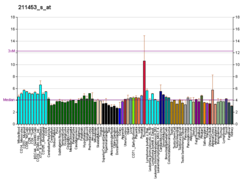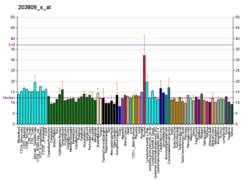AKT2, also known as RAC-beta serine/threonine-protein kinase,[5] is an enzyme that in humans is encoded by the AKT2 gene.[6] It influences metabolite storage as part of the insulin signal transduction pathway.[5]
Function
This gene is a putative oncogene encoding a protein belonging to the AKT subfamily of serine/threonine kinases that contain SH2-like (Src homology 2-like) domains. The encoded protein is a general protein kinase capable of phosphorylating several known proteins.[7]
AKT2 has important roles in controlling glycogenesis, gluconeogenesis, and glucose transport as part of the insulin signal transduction pathway.[5]
Clinical significance
The gene was shown to be amplified and overexpressed in 2 of 8 ovarian carcinoma cell lines and 2 of 15 primary ovarian tumors. Overexpression contributes to the malignant phenotype of a subset of human ductal pancreatic cancers.[7]
Mice lacking Akt2 have a normal body mass, but display a profound diabetic phenotype, indicating that Akt2 plays a key role in signal transduction downstream of the insulin receptor. Mice lacking Akt2 show worse outcome in breast cancer initiated by the large T antigen as well as the neu oncogene.[8]
Interactions
AKT2 has been shown to interact with:







